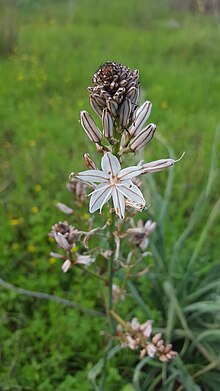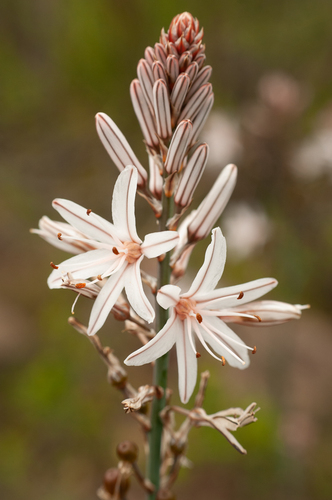Branched Asphodel
Search
Wikipedia
| Asphodelus ramosus | |
|---|---|

| |
|
Scientific classification | |
| Kingdom: | Plantae |
| Clade: | Tracheophytes |
| Clade: | Angiosperms |
| Clade: | Monocots |
| Order: | Asparagales |
| Family: | Asphodelaceae |
| Subfamily: | Asphodeloideae |
| Genus: | Asphodelus |
| Species: |
A. ramosus
|
| Binomial name | |
|
Asphodelus ramosus | |
| Synonyms | |
|
Asphodelus microcarpus Viv. | |
Asphodelus ramosus, the branched asphodel, is a perennial herbaceous plant in the order Asparagales. Similar in appearance to Asphodelus albus and particularly Asphodelus cerasiferus and Asphodelus aestivus, it may be distinguished by its highly branched stem and smaller fruits.[1][2] There has been a lot of confusion over the nomenclature and taxonomy of the species, owing to its similarity to Asphodelus aestivus.[3][4]
Asphodelus ramosus is native to the Mediterranean region of southern Europe, northern Africa, and the Middle East. It can also be found in the Canary Islands.[5][6][7][8][9] It is particularly common in coastal areas of the Mediterranean with intensive grazing and occasional fire. In some areas it shows an affinity for acidic soils, mainly schist. It can form abundant colonies, usually flowering in February to May.[10][1] It has been thought to be Homer's asphodel of the underworld,[11] but so has the closely related Asphodeline lutea. The branched asphodel is known to contain colchicine, a chemical used in the treatment of gout.[citation needed]
Physical characteristics
Asphodelus ramosus is a geophyte, having an underground storage organ which enables the plant to survive adverse conditions, such as excessive heat and drought. Its leaves, growing to a height of 60 centimetres (24 in)–80 centimetres (31 in), contain alkaloids that are harmful to sheep and goats in the wet, winter months, but during the summer when their leaves dry out, they lose their toxicity.[12][13] Its very numerous flowers are white with six tepals bearing a central brown streak. The fruits are small round capsules.[14]
Uses
Some traditional folk usages of the plant have been to make a glue from the plant's root. A remedy against warts is also derived from its root.[13] According to Dioscorides, a concoction made from its roots (mixed with wine) induces vomiting.[15] Formerly, the entire plant was used in treating poisonous snake bites (its efficacy yet to be proven scientifically).
References
- ^ a b Altervista Flora Italiana, Asphodelus ramosus includes photos plus European distribution map
- ^ Lectotypification of Asphodelus ramosus (Asphodelaceae), a Misunderstood Linnaean Name
- ^ Lifante, Zoila Díaz; Valdés, Benito (1994). "Lectotypification of Asphodelus ramosus (Asphodelaceae), a Misunderstood Linnaean Name". Taxon. 43 (2): 247–251. doi:10.2307/1222883. JSTOR 1222883.
- ^ "Vascular plants of Greece: an annotated checklist", Englera 31, Botanic Garden and Botanical Museum Berlin-Dahlem, retrieved 2018-03-04
- ^ Kew World Checklist of Selected Plant Families
- ^ Dobignard, D. & Chatelain, C. (2010). Index synonymique de la flore d'Afrique du nord 1: 1-455. Éditions des conservatoire et jardin botaniques, Genève.
- ^ Davis, P.H. (ed.) (1984). Flora of Turkey and the East Aegean Islands 8: 1-632. Edinburgh University Press, Edinburgh.
- ^ "The Euro+Med PlantBase", the information resource for Euro-Mediterranean plant diversity, Botanic Garden and Botanical Museum Berlin-Dahlem, retrieved 2018-03-04
- ^ "Plants of the World Online", the reference for global plant names, Royal Botanic Gardens, Kew, retrieved 2020-08-11
- ^ "Flora of Israel Online", Analytical Flora, The Jerusalem Botanical Gardens, retrieved 2020-08-11
- ^ Anonymous (May–October 1887). "Homer the botanist". Macmillan's Magazine. London: Macmillan and Company. 56: 428–436. Retrieved 3 November 2014.
- ^ Rhizopoulou, S. (1997). "Ecophysiological Adaptations of Asphodelus aestivus auct. (=ramosus) to Mediterranean Climate Periodicity: Water Relations and Energetic Status". Ecography. 20 (6): 626–633. doi:10.1111/j.1600-0587.1997.tb00431.x. JSTOR 3683251.
- ^ a b Avi Shmida, MAPA's Dictionary of Plants and Flowers in Israel, Tel-Aviv 2005, s.v. Asphodelus aestivus auct.=ramosus (p. 77) ISBN 965-521-017-0 (Hebrew)
- ^ Danin, A. (2004). Distribution Atlas of Plants in the Flora Palaestina area: 1-517. The Israel Academy of Sciences and Humanities, Jerusalem.
- ^ Dioscorides, De Materia Medica (Book II, § 199).

